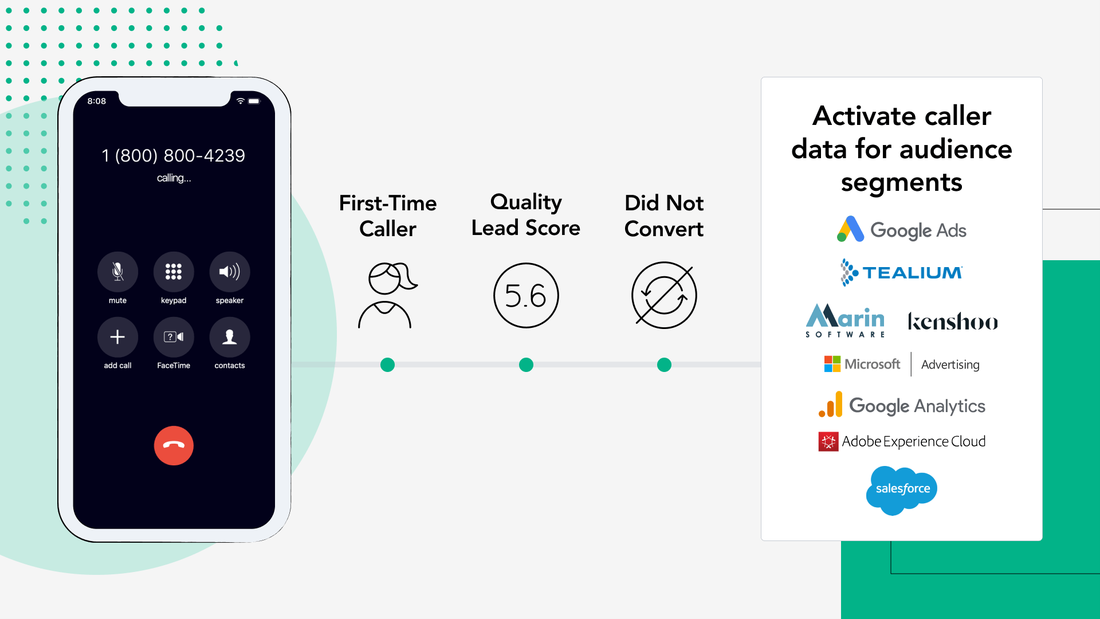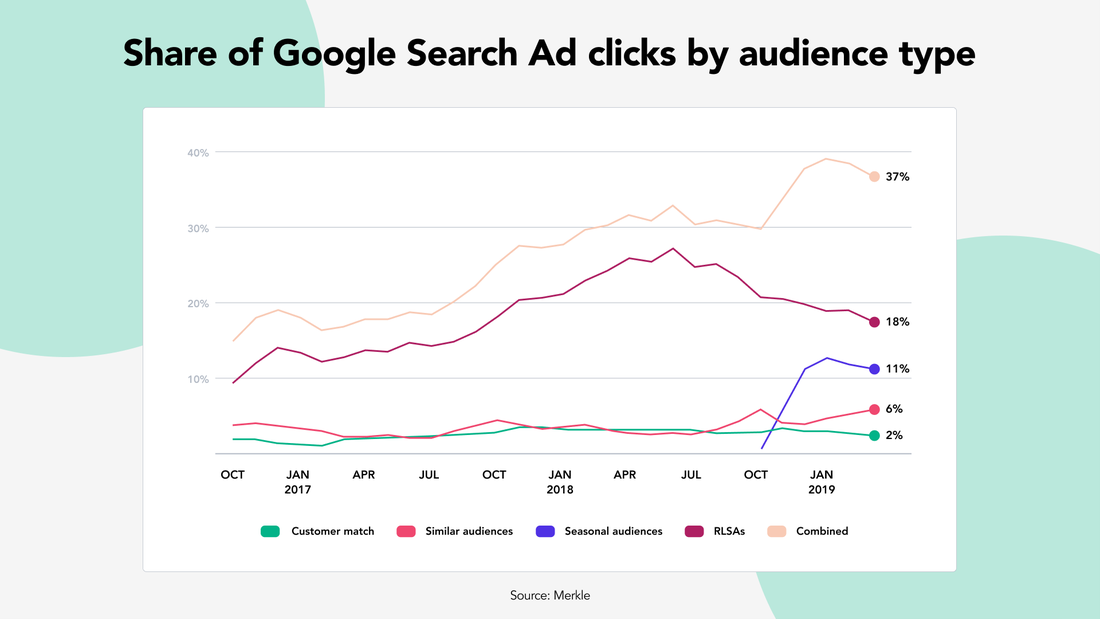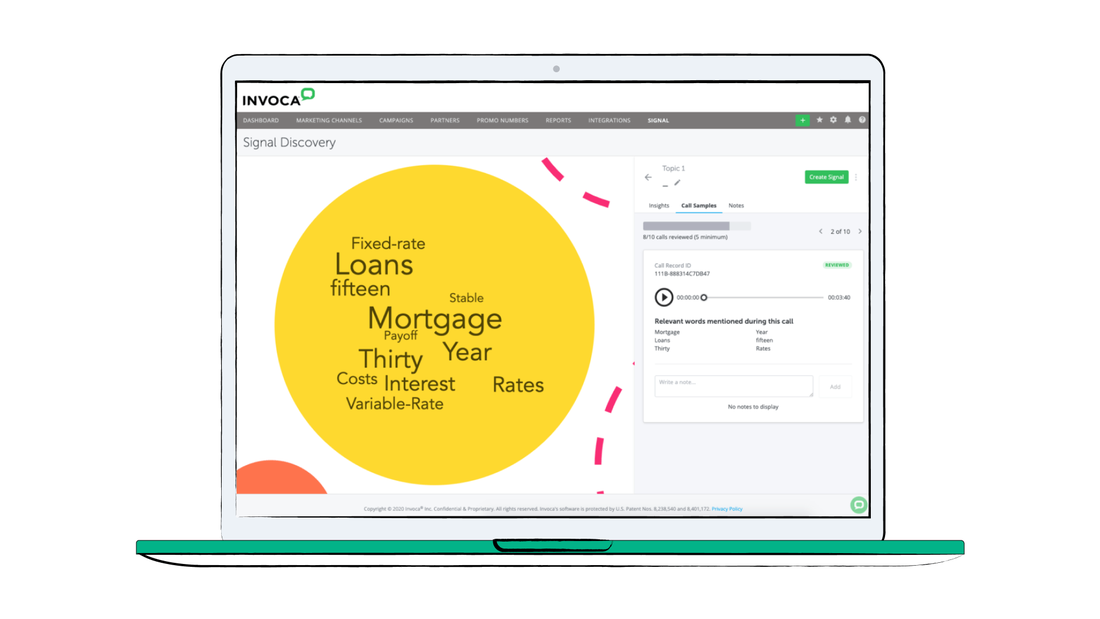
The third-party tracking cookie has been crumbling since 2018 and it’s usefulness for audience tracking has waned significantly since. Most browsers block third-party cookies by default now and regulations like GDPR and the California Consumer Privacy Act (CCPA) also restrict consumer tracking using third-party data. This marks a fundamental shift in the marketing landscape—brands that once relied on third-party tracking cookies to find and target audiences need to alter their approach.
The good news is that there are still a variety of other tactics you can use for audience targeting without cookies. Instead of relying on third-party cookies to collect insights on their audiences, marketers are finding success by harnessing their first-party data—including insights from what consumers say when they call the business—and using it to deliver more personalized experiences, serving the right message to the right consumer at the right time.
In a post-third-party cookie world, conversation intelligence solutions like Invoca allow marketers to tap into that often-overlooked source of first-party data: consumer calls.
Let’s look at the implications of these new browser updates and regulations on your marketing, how first-party data from consumer calls and insights from conversations can help fill the void, and 3 tips marketers can use to enhance their audience targeting in a post-third-party cookie world.
A tracking cookie is a small piece of code that a website stores as a text file on a user’s browser. Employing the user’s IP address as a unique ID, the cookie then captures data about the user as they browse the web.
Cookies are not inherently bad, nor do they inherently invade your privacy—in fact, 45% of websites use cookies. They are responsible for much of the common website personalization we see today. When brands use website cookies for audience targeting, your data is anonymized. Additionally, you can clear them from your browser at any point. However, bad actors are using third-party cookies and nefarious techniques known as “fingerprinting” to track users in ways they cannot easily control or prevent—hence the new browser updates.
First-party cookies: First-party cookies are created by—and track activity on—the website the user is currently viewing. They do not track the user across outside domains. First-party cookies are vital for providing a consistent experience across a brand’s website. Without them, you wouldn’t be able to stay logged in across a domain’s website pages, put an item in your online cart and continue shopping, or receive product recommendations tailored to your shopping history.
In that sense they can be a win-win for brands and consumers. The brand gets to provide the consumer a more personalized experience that is more pleasant for the consumer and often more profitable for the brand.
Though first-party cookies track activity on websites the user is voluntarily visiting and provide the level of website personalization we’ve become accustomed to, Safari and Firefox may now reduce how long first-party cookies are active. For example, as part of Apple's ITP 2.2 changes, 1st party cookies in Safari will expire after 1 day. However, if the user revisits the site within 24 hours, the cookie will be refreshed.
Third-party cookies: Third-party cookies allow websites to track users across domains. For instance, while you’re shopping for grills on a retailer’s website, another company could set a third-party cookie on your browser, which would track your session data from the retailer. That other company could, in turn, sell this data.
Browsers and regulatory agencies are now blocking third-party tracking cookies because bad actors can use them to collect your data without your explicit permission.
Much of the martech ecosystem has been built around third-party cookies. Advertisers used them to understand audience behavior, including their location, interests, the webpages they visit, and the products they buy.
But now, instead of relying on cookies and looking to third parties to inform their audience targeting, marketers are making a concerted shift to fully leverage their first-party data. In fact, a recent industry survey found that 82% of marketers plan to increase their use of first-party data.
First-party data contains rich insights about your already-existing prospects and customers that marketers can leverage to personalize consumer experiences and drive better business results. Additionally, it provides a competitive advantage since you maintain exclusive access to it. Companies often have swaths of untapped first-party data at their disposal, including subscription data, CRM data, purchase data, app data, and data from phone calls to their call centers and locations. But advances in martech powered by AI are helping them turn this data into actionable insights to improve performance and results.
When a consumer calls your business, they’re engaging in a multi-dimensional interaction with your brand that offers far more information than clicks or digital forms can collect. Phone conversations are literally telling you the caller’s intent, urgency, and preferences. They are relaying what products and services the consumer is interested in, where they are in the customer journey, what barriers exist to the sale, and much more. And at the end of the call, you have all the data you need to tell if they are a good lead, if they converted to a sales opportunity or appointment, or customer, and what the next best action is.
To capture this data at scale, marketers are using call tracking and conversation intelligence solutions like Invoca that are powered by AI. With call tracking, marketers can capture not only what marketing campaign and online interaction drove a call, but identifiers for who that caller is, including their phone number. Then, with conversation intelligence, you get a deep understanding of why the consumer is calling and the outcome of the call.
All this data on each caller can then be activated in digital ad platforms like Google Ads, Microsoft Ads (Bing), and Facebook, as well as digital marketing tools like Google Marketing Platform, Adobe Experience Cloud, LiveRamp, and more to better target those consumers across search, social, and display with the right message at the right time to convert them.
In a post-third-party cookie world, marketers can still use a combination of martech and adtech solutions—including Invoca—to support audience targeting. Here are 3 strategies to consider.
In the absence of third-party cookies, more marketers are using people-based marketing for audience targeting without cookies. People-based marketing is the process of combining insights from every consumer interaction to build comprehensive audience profiles. Marketers then use these profiles to deliver relevant, helpful, and personalized experiences across multiple devices in real time, whether online, in person, or over the phone.
People-based marketing works by uploading all the offline consumer data you have at your disposal—CRM data, email addresses, job titles, purchase history, call analytics data, and more—to a secure identity resolution or customer data platform like LiveRamp, Tealium, or Signal. The platform then ties it to your online data sources. Finally, the platform constructs comprehensive consumer profiles and anonymizes them with unique identifiers.
But keep in mind, your people-based marketing is only as good as your data. The more attributes you know about each consumer, the more accurate your identity resolution profiles will be. A disconnect in channel data can result in incorrectly tailored experiences that waste spend and alienate potential customers. However, when executing people-based marketing campaigns, most brands have only connected a few of their channels. A 2019 study by Evergage found that 74% of brands had less than half of their channels connected—and 21% had none.
To enhance audience targeting, leading marketers are pushing their call analytics data to their identity resolution or customer data platforms. This includes identifying personal data such as the caller’s name, phone number, and the geographic location they called from, as well as data mined from the conversation, such as whether the caller was a quality sales lead, their product/service interests, and if they converted to a sale.

This data provides valuable insights into consumer purchasing intent and can help you re-engage them with more relevant ads. For instance if you are an insurance provider and someone placed a call, stated their interest in car insurance, but didn’t convert, you could retarget this caller with relevant digital ads for auto insurance across various channels.
Most marketers are familiar with building audiences from their own consumer data in Google Ads and Facebook Ads Manager. You import lists of consumer email addresses or phone numbers, and Google and Facebook can retarget them with the best ad messaging, use them in lookalike campaigns, or exclude them from seeing irrelevant ads.
It’s a practice that is growing in popularity. According to Merkle’s Q1 2019 Digital Marketing Report, customer match and similar audience clicks from Google search ads are growing. Conversely, clicks from cookie-based RLSA (Remarketing Lists for Search Ads) audiences are in decline.

To inform their audience targeting with additional first-party data, marketers are using Invoca conversation intelligence to capture insights from consumer phone conversations. Based on those insights, Invoca segments callers into nuanced lists and passes the lists to Google Ads and Facebook Ads Manager to better inform targeting. For example, marketers could use Invoca to create lists of callers who expressed interest in a particular product/service but didn’t convert. They could then target members of this list with additional ads for that product/service, possibly with special offers. They could also create lists of callers who bought that product/service over the phone to exclude them from seeing future ads for it. Or build lookalike audiences based on callers who did convert.
An additional tactic to reach your target audience in a post-third-party cookie world is to use persona-based SEO strategies. Instead of targeting them proactively with Facebook or display ads, this tactic works to entice the right audiences to your site when they search for relevant products. By creating and optimizing content that appeals to different audience segments, you’ll be able to bring them to your website organically when they are in the market and actively shopping.
Before you begin to develop an SEO strategy, you’ll need to gather insights to build a profile of your target audiences. You’ll need to determine the demographics of each audience, how they navigate the site, and what content drives the most leads. Then, by collaborating with sales and leadership teams, you can learn the key phrases your audience is voicing, the content that excites them, and the pain points they’re experiencing. In addition, conversation intelligence solutions like Invoca Signal Discovery can offer valuable insights into how your audience is talking about your products, what key phrases they use, and what questions they frequently ask.

Once you’ve fleshed out a profile of your target audience, you can begin crafting an SEO strategy tailored to their needs. Start by optimizing your most important lead-generation pages for the keywords that your audience frequently voices. Next, add messaging that addresses your audience’s specific pain points and fills their knowledge gaps. Finally, streamline your navigation—if there are certain pages that usually send your audience bouncing back to the homepage, the navigation may be confusing and need retooling.
After you’ve successfully implemented this strategy, your audience will come to you organically to read content that interests them and answers their burning questions. In addition, when you streamline your website according to your target audience’s navigation tendencies, they will stay engaged longer and your conversion rate will increase.

The original version of this page was published at: https://www.invoca.com/blog/audience-targeting-without-cookies
Invoca for Healthcare enables healthcare providers to capture detailed analytics on a new patient’s full journey. This includes the marketing campaign that drove initial interest, the specific webp... Read more
When the ball drops on New Year’s Eve, you probably won’t be thinking about snooze-worthy stuff like popping a new bottle of bubbly or smooching your sweetheart — ...read more
Economists are predicting a recession in 2023 and marketers know all too well what this means: their budgets will be under pressure. A recent study found that about a third ...read more
Healthcare marketing statistics suggest spending on digital advertising by the healthcare and pharmaceutical industries will reach $20 billion next year, according to some projections. ...read more
Five years ago, McKinsey Global Institute stated in a discussion paper on AI use cases that marketing was one of the top areas presenting the greatest value opportunities for ...read more